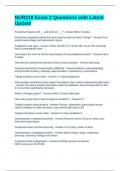NUR218 Exam 2 Questions with Latest
Update
Puerperium begins with __ and ends @ ___? - Answer-Birth, 6 weeks
During the postpartum period the nurse must be alert for what 2 things? - Answer-Post
partum hemorrhage and hypovolemic shock
Postpartum vital signs - Answer-Temp- 98-100.4, P- 50-90, RR- 16-24, BP should go
back to prepregnant state
How long is the mom at risk for preeclampsia in the postpartum period? - Answer-Up to
2 weeks
The perineal assessment should be done in which position - Answer-Side lying
Perineal assessment characteristics (REEDA) - Answer-Redness, edema/swelling,
ecchymomsis/ bruising, drainage, approximation of episiotomy or lacerations
Taking in phase occurs when - Answer-1-2 days postpartum
What position should the nurse advise the patient to be in when experiencing after pains
- Answer-The prone position with pillow under the abdomen. May increase pain for first
5 min but then significantly decrease
When is Rhogam given? - Answer-within 72 hours after birth
How many days does it take to suppress lactation? - Answer-5-7
Taking in phase characteristics - Answer-Passive, dependent, preoccupied w/own
needs, hesitates to make decisions, may need to talk about L&D
Taking hold phase occurs when - Answer-2-3 days postpartum
Characteristics of taking hold phase - Answer-Resume control, focus on infant care,
may need reassurance
Postpartum blues can last how long - Answer-10-12 days, peak 3-5 days
Characteristics of postpartum blues - Answer-Mood swings, anger, weepiness,
anorexia, insomnia, feelings of let down
Postpartum labs & diagnostics - Answer-Hct/hbg increase w/ diuresis
WBC increase to 20-25,000
,Coag/fibrinogen remain high for 6 weeks
Rubella vaccine is given postpartum if titles are - Answer-<1:8
If the mother is Rh- and indirect Coombs - & baby is Rh+ the mother is given - Answer-
Rhogam
If the mom has a decrease in hct this could be a sign of - Answer-Hemorrhage
Involution - Answer-The return of the uterus to pre-pregnant size & condition after
placental delivery
Characteristics of involution - Answer-Firm contracted uterus, size of grapefruit
immediately after delivery, midline between symphysis pubis & umbillicus, decrease
1cm/day
Subinvolution - Answer-Failure to return to normal sized uterus
Characteristics of subinvilution - Answer-Boggy uterus, high in abdominal region,
deviated to side, increase in lochia
If the fundus is deviated to the ride side it is most likely caused by - Answer-A full
bladder
Lochia - Answer-Discharge which rids uterus of debris
Average duration & range of lochia - Answer-Duration 3-4 wks, range 2-6 weeks
Measuring lochia - Answer-Scant >1in, light 1-4in, moderate 4-6 in, heavy saturated in
1hr
Lochia rubra - Answer-Dark red, birth - 3 days postpartum
Lochia serosa - Answer-Pink-brown, 4-10 days postpartum
Lochia alba - Answer-White-yellow, 11-21 days postpartum
Cervical changes - Answer-Permanent, external os change from dimple like to
transverse slit after 1st vaginal birth
Vaginal change postpartum - Answer-Gradual return within 3-4 weeks, muscle tone
never returns completely
Perineum change postpartum - Answer-Initial healing 3-4 weeks, may take 4-6 months
to completely heal
, Recurrence of ovulation/ menstruation in non breastfeeding moms - Answer-Menses 4-
6 weeks, ovulation 27 days average 70-75 days postpartum
Recurrence of ovulation/menstruation in exclusive breastfeeding moms - Answer-3-6
months
Recurrence of ovulation/menstruation in breastfeeding moms where supplements are
also used - Answer-Similar to non breastfeeding moms
Characteristics of colostrum - Answer-Thick creamy yellow, 2-3 days postpartum
Colostrum is created during which trimester - Answer-2nd- beginning of 3rd
Characteristics of transitional milk - Answer-Light yellow thin, day 2-14
Characteristics of mature milk, - Answer-White or blue tinged, present by 2 weeks
Urinary retention postpartum - Answer-Unable to empty bladder, uterine displacement
(atony), increased vaginal bleeding & cramping
Postpartum wt loss - Answer-10-12lbs initially, additional 5lb to diuresis, return to pre
pregnant weight within 6-8 weeks only if gained recommended amount
Postpartum chill - Answer-Short term, immediate after birth, no fever- no concern
Afterpains - Answer-Intermittent contractions of uterus
Causes of after pains - Answer-Increase with multipara/ multi gestation,
polyhydramnios, breast feeding & oxytocic agents
How often should the mothers vitals signs, uterine tone, fundal height/location and
lochia be assessed during the 1st hour postpartum - Answer-Every 15 minutes
How often should the mothers vitals signs, uterine tone, fundal height/location and
lochia be assessed during the 2nd hour postpartum - Answer-Every 30 minutes
How often should the mothers vitals signs, uterine tone, fundal height/location and
lochia be assessed 2-4 hours after birth - Answer-Every 1 hr
After the 4th hour postpartum how often should the mothers vital signs, uterine tone,
fundal height/location and lochia be assessed - Answer-Every 4-8 hours until discharge
If the uterus is boggy what action should be performed - Answer-Uterine massage then
encourage to void
Warmed bath blankets prevent - Answer-Postpartum chill




